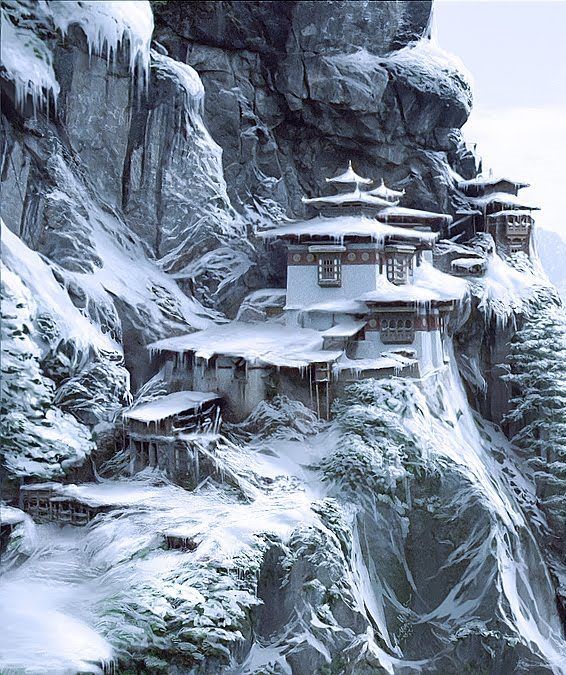Difference between revisions of "Kingdom of Bhutan"
Tao alexis (talk | contribs) |
Tao alexis (talk | contribs) |
||
| (4 intermediate revisions by the same user not shown) | |||
| Line 1: | Line 1: | ||
| + | [[File:Kingdom of Bhutan.jpg|right|525px|thumb]] | ||
The '''Kingdom of Bhutan''' is an obscure mountainous realm within the Eastern Himalayan mountains, Buddhist since the 7th century. The region has been described as the ''land of the thunder dragon''. Despite the land's topographical isolation, it provides many [[Trading System|trade goods]] that are transported to the [[Market|market]] of Koch Bihar during the dry season. | The '''Kingdom of Bhutan''' is an obscure mountainous realm within the Eastern Himalayan mountains, Buddhist since the 7th century. The region has been described as the ''land of the thunder dragon''. Despite the land's topographical isolation, it provides many [[Trading System|trade goods]] that are transported to the [[Market|market]] of Koch Bihar during the dry season. | ||
| Line 4: | Line 5: | ||
== Geography == | == Geography == | ||
| − | The region's southern boundary shares the lush subtropical plains north of the Brahmaputra river, a mere 600 to 700 ft. above sea level. | + | The region's southern boundary shares the lush subtropical plains north of the Brahmaputra river, a mere 600 to 700 ft. above sea level. Moving north twenty to forty miles, the land rises rapidly to mountains that are more than 23,000 ft. above sea level. Gangkar Punesum, 24,836, is the highest mountain in the kingdom. Much of the northern part consists of [[Alpine (range)|alpine ranges]] or [[Snowfield (range)|snowfields]]. The seat of the realm, Thimphu, in the western country, is 8,978 ft. above sea level. |
| + | == History == | ||
| + | According to legend, Bhutan was united as a kingdom in the 7th century <small>BCE</small>, but little knowledge about the country exists before the 9th century <small>AD</small>. In the 12th century, the Drukha Kagyupa school was established, where many of the greatest [[Monk (class)|monks]] of the world originally received their training. For most of history, Bhutan has existed as a collection of isolated [[Village|village]] states, coming together to defend the land when it needed defending. The country was united under a lama, Ngawanag Namgyal, in 1616; it presently exists as a theocracy. | ||
| − | {| class="wikitable | + | == Trade == |
| − | + | There are no markets in Bhutan. | |
| − | ! | + | |
| − | ! | + | {| class="wikitable" style="float:left; margin-right: 25px; text-align: center; background-color:#F7E7CE;" |
| + | |+Region | ||
| + | ! style="width: 85px|Place !! style="width: 105px"|Topography || style="width: 215px"|Product References | ||
|- | |- | ||
| − | | align="left"| | + | | style="text-align: left"|'''Bhutan''' || region || cloth, jute, baskets, mats, metalsmithing, barley, maize, millet, rice (2), wheat, mustard seed, tea (2), oranges, potatoes, elephants |
| + | |} | ||
| + | {| class="wikitable" style="float:left; margin-right: 25px; text-align: center; background-color:#F7E7CE;" | ||
| + | |+Settlements | ||
| + | ! style="width: 85px|Name !! style="width: 65px"|Population || style="width: 65px"|Year<br>founded | ||
| + | |- | ||
| + | | style="text-align: left"|'''Taga Dzong''' || |2,272 || 168 <small>BCE</small> | ||
|- | |- | ||
| − | | | + | | style="text-align: left"|'''Thimphu''' || 1,616 || 357 |
|- | |- | ||
| − | | | + | | style="text-align: left"|'''Trongsa Dzong''' || 3,849 || 110 |
|} | |} | ||
| − | + | [[Category: Political Divisions of the World]][[Category: Don't Review until 2023]] | |
| − | |||
| − | |||
| − | [[Category: | ||
Latest revision as of 17:37, 19 March 2025
The Kingdom of Bhutan is an obscure mountainous realm within the Eastern Himalayan mountains, Buddhist since the 7th century. The region has been described as the land of the thunder dragon. Despite the land's topographical isolation, it provides many trade goods that are transported to the market of Koch Bihar during the dry season.
The Kingdom covers an area of 42 hexes and has a population of 116,059. It borders on Tibet, Towang, Ahom, Koch Hajo, Dooars, Gorkhaland and Sikkim.
Geography
The region's southern boundary shares the lush subtropical plains north of the Brahmaputra river, a mere 600 to 700 ft. above sea level. Moving north twenty to forty miles, the land rises rapidly to mountains that are more than 23,000 ft. above sea level. Gangkar Punesum, 24,836, is the highest mountain in the kingdom. Much of the northern part consists of alpine ranges or snowfields. The seat of the realm, Thimphu, in the western country, is 8,978 ft. above sea level.
History
According to legend, Bhutan was united as a kingdom in the 7th century BCE, but little knowledge about the country exists before the 9th century AD. In the 12th century, the Drukha Kagyupa school was established, where many of the greatest monks of the world originally received their training. For most of history, Bhutan has existed as a collection of isolated village states, coming together to defend the land when it needed defending. The country was united under a lama, Ngawanag Namgyal, in 1616; it presently exists as a theocracy.
Trade
There are no markets in Bhutan.
| Place | Topography | Product References |
|---|---|---|
| Bhutan | region | cloth, jute, baskets, mats, metalsmithing, barley, maize, millet, rice (2), wheat, mustard seed, tea (2), oranges, potatoes, elephants |
| Name | Population | Year founded |
|---|---|---|
| Taga Dzong | 2,272 | 168 BCE |
| Thimphu | 1,616 | 357 |
| Trongsa Dzong | 3,849 | 110 |
